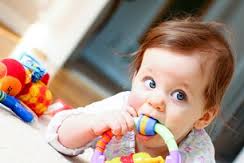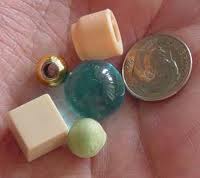Choking prevention and First Aid for Babies
January 10, 2014 by admin
Filed under Baby Problems
 Choking is a major risk for infants and toddlers. Choking is a foreign object that is stuck at the back of the throat or cause muscular pains. High risk of choking is observed in little babies and toddlers who have started to crawl around. Young children below 5 years are also prone to choking. During movement from one place to another they will come across objects which they try to put into the mouth.
Choking is a major risk for infants and toddlers. Choking is a foreign object that is stuck at the back of the throat or cause muscular pains. High risk of choking is observed in little babies and toddlers who have started to crawl around. Young children below 5 years are also prone to choking. During movement from one place to another they will come across objects which they try to put into the mouth.
Choking risks for babies and toddlers:
Any object smaller than a D size battery is a choking risk for babies and toddlers. Keep away tiny objects away from the baby. Even baby toys that are detachable can be a cause of concern. Baby gets attracted to bright colors and will stuff into the mouth. The other concern is health as these objects are not clean and can cause stomach upset and watery motions.
Precautions to avoid choking:
Let us understand the various ways to prevent choking in babies and toddlers.
- Feed the baby in sitting position: The correct posture to feed a baby who has weaned is in the sitting position. If the baby runs around and plays while eating there is a high risk of choking. Keep the baby engaged by conversing or singing some songs / rhymes this will ensure he does not shift focus. He will be less tempted to move around. This way choking risk is eliminated.
- Feed small portion: Till the time the child develops a chewing habit, feed in small quantities i.e the size of a small chick pea. Do not feed large pieces like salad, carrot pieces etc. High chances of choking. The babies airways are small and any large particle will get blocked and cause choking.
- Clear baby’s area of small objects: Babies are very curious about the objects in the surrounding. They are captivated by the colors and shapes. They will put any object into the mouth. Check the area and clear small objects eg: coins,beads,fruits, nuts etc.

- Avoid detachable toys: Check toys during purchase. If you have received gifts for the baby check the toys for any sharp surfaces, loose parts. Check toys ongoing basis to ensure no safety risks / choking risks. Small loose parts can be placed into mouth. Keep a close supervision of the baby.
- Separate toys of the older children: Every child is engaged by the toys associated with their age. If there are siblings you need to watch out for the toys they play with. It is a common observation that little babies always love the items that are in the hands of the other kid i.e a toy or a pencil etc. If the sibling is a school going one keep stationary items out of the reach eg: rubber, sharpener, crayon pencils etc.
Read: How to make home safe for kids
Symptoms of choking in babies:
If your baby is suddenly unable to breathe, cry, cough or make noise i.e baby is still, not moving . This is a sign that the baby’s airways are blocked indicating choking.
You need to act fast and restore baby’s breathing. The baby will try to cough, it is a natural tendency but will be unable to do it. Your aim is to remove the obstruction and take the baby to the Doctor for further diagnosis.
How to act fast- First Aid for choking in infants
If the infant is worried and distressed, unable to cry, cough, or breathe:
- Lay them face down along your forearm, with their head low, and support the back and head
- Give up to five back blows, with the heel of your hand
- Check the infant’s mouth; remove any obvious obstructions
- Do not do a finger sweep of the mouth.
If the obstruction has not cleared, follow these steps:
- Turn the infant onto his back and give up to five chest thrusts
- Use two fingers, push inwards and upwards (towards the head) against the infants breastbone, one finger’s breadth below the nipple line
The aim is to relieve the obstruction with each chest thrust rather than necessarily doing all five
- Check the mouth.
- If the obstruction does not clear after three cycles of back blows and chest thrusts conduct CPR( Cardio Pulmonary Resuscitation) . This is basically providing breathe to the baby.
When the baby breath is restored, clean the baby and keep him comfortable as they will make a lot of noise mainly because of the pain and the sudden alarm the baby had gone through. Ensure you take the baby to the doctor the same day for checkup and inputs.
Do your best to prevent choking for your baby. Mothers with multi-tasking activities and the care takers or grand parents who are responsible for caring the baby in the absence of the mother need to be extra cautious.
You can include your inputs for Choking prevention and share your experiences in the comments.









